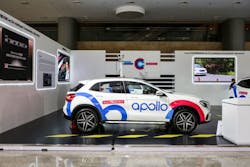LAS VEGAS. Autonomous technology could be found just about everywhere at CES 2018.
From improving mobility options for senior citizens and the disabled, to the safety and efficiency benefits of developing smarter cities, it does not appear the absence of federal regulations or a high level of public skepticism can derail the momentum fueling the autonomous movement.
Here is a round up of some of the announcements and exhibit booth presentations during CES:
Intel introduced its first autonomous car to its 100-vehicle test fleet. The announcement was made during CEO Brian Krzaich’s keynote address. The vehicle features 12 cameras, radars, and laser scanners. Some of the technology comes from Intel’s Mobileye unit.
Intel also said about two million passenger vehicles from various manufacturers will use technology from Mobileye to build high-definition maps throughout 2018.
Ford, ZF, and Hyundai Mobis were among the other companies focusing on connectivity and autonomous technology during the show.
Bosch’s message focused in part on how connected vehicles are a key piece in the development of smart cities. For example, “community-based parking” can help cars automatically locate vacant parking spaces.
Bosch’s press material also included a mention of its telematics platform for heavy-duty trucks, developed with Daimler Trucks and Fleetboard. The remote diagnostics system received the CES 2018 Innovation Award in the Tech For A Better World category.
Continental Automotive promoted its self-driving vehicle concept called “BEE,” or Balanced Economy and Ecology. The company also touted how it can help create smarter cities, and outlined a series of electronic solutions, including an automated trailer solution for pick-up trucks and SUVs.
Workhorse Group not only showed off sits W-15 electric pickup truck and N-Gen delivery van, but also the two-seat SureFly electric hybrid helicopter. The $200,000 copter was scheduled to take a test flight during CES, but it was called off due to poor weather. Workhorse has said future models will be capable of autonomous flight.
Officials with Ryder System were also stationed at Workhorse’s booth. The company reached a deal last year to sell and service Workhorse’s vehicles.
Clarion and Hitachi demonstrated an autonomous valet parking system, which featured a completely driverless vehicle in a closed-off parking area. Another demo featured “park by memory” technology, illustrating how vehicles can learn to park itself in familiar settings, such as home garages.
Visteon Corp. introduced the DriveCore autonomous controller, a platform that enables automakers to build autonomous driving solutions in an open collaboration model. It showed a range of all-digital display systems, including an instrument cluster with integrated driver monitoring infrared cameras for facial recognition and head and eye-gaze tracking.
China-based Baidu Inc. unveiled its own autonomous innovations, including Apollo 2.0, which it called the most robust version the company’s open autonomous driving platform.
Baidu also inked an agreement with BlackBerry to jointly develop self-driving vehicle technology. It has similar agreements with Qualcomm, Denso, and Aptiv.
Cognata Ltd. announced it was launching a cloud-based simulation engine for autonomous vehicle validation powered with technologies from Nvidia and Microsoft. Nvidia, a chip maker, also said it was also partnering with Uber and Volkswagen on driverless cars. It rolled out the “Driver Xavier” at CES, a new system-on-a-chip designed to ramp up computing power.
Cognata said vehicle makers are required to accumulate 10 billion miles worth of test drives. Cognata’s simulation platform can advance that process by enabling autonomous vehicle manufacturers to log realistic virtual test drives on the virtual roadways of its simulated environment, trimming years off the testing process.
Connected Signals demonstrated how awareness of traffic light information can make driving safer and more fuel efficient. Through its smartphone app, it showed real-time information on what speed a person should drive in order to catch green lights.
Gentex Corp. showed connected vehicles features and biometric-based security. Its in-vehicle biometrics system authenticates the driver with an iris scan that is part of the rearview mirror.
Valeo displayed a system that allows the interior climate of a vehicle to be adjusted to each passenger’s physical condition and sensitivity to temperature. The system can also detect the driver’s mood and release stimulating or soothing fragrances in the event of tiredness or stress.





